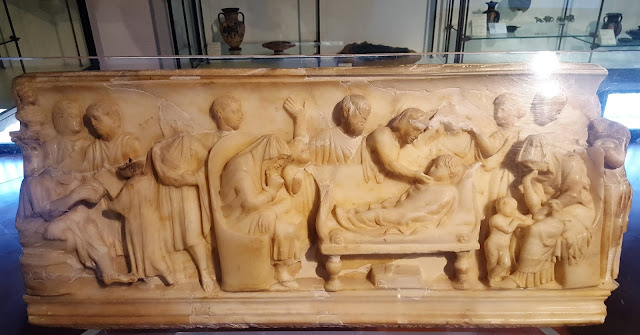Tempio della Concordia (Temple of the Concord) is considered the best-preserved Greek temple still existing, owing mostly to its having been used for centuries as a Christian church. It's just one of the many temples and ruins between the modern town of Agrigento and the southern coast of Sicily. Photos of Concordia, which is beautifully illuminated at night and appears to float in a dark sky, should put Agrigento on the itinerary of any trip to Sicily.
Most of the temples and other sites are along a walkway that runs the length of the Valley of the Temples, which are considered to be the finest Greek ruins in the world, along with those of the Acropolis in Athens. Ruins of residential areas and a fine archeological museum are along the road between the valley and the modern town. (The term "valley," by the way, is wrong. The temples are strung along a ridge that overlooks the Mediterranean Sea.) In October 2020, the New York Times published an article about plans in Agrigento to reassemble stones from a gigantic figure at one of the temples. My photo of one of these reassembled titans is among the pictures below.
We were still in Siracusa when we started having second thoughts about Agrigento, mainly about the fact that the inn we originally booked did not have a pool. Siracusa was very sunny and very hot, though it was right on the sea. Agrigento, a mile or so inland, would be even hotter, we thought, and we wanted a pool. One hotel in Agrigento appealed to us: Villa Athena, which is not only within walking distance of the Valley of the Temples, it has its own entrance to the park and it has day and night views of Concordia and the Temple of Juno. And a pool. I called and was told that the only room available was a suite at several hundred euros a night. Jane went online and found a "comfort" class room there for less than 200 euros a night. We booked it and cancelled our previous reservation. No idea why the front desk had told me only the suite was available.
Villa Athena is a house from the 1700s that has been expanded with several wings and out buildings to become a very posh hotel. Our ground-level "comfort" room was very comfortable. It was entered via our own terrace from a sidewalk, which meant mostly keeping curtains drawn for privacy. But the room was large, beautifully furnished and had a superb bathroom and shower. And CNN on TV, which we rarely found in the more modest inns where we usually stayed.
The town of Agrigento was a short taxi ride from Villa Athena. We didn't take our own car because parking in old walled towns in Italy is a nightmare. We did, however, drive to a nearby beach at San Leone. It took less than 10 minutes, but it would have been a terrible walk.
 |
| A small fence keeps visitors from climbing the steps and entering the temple. The Doric columns that surround the temple appear to be repeated inside. |
 |
| Another view shows the walls and arches of the interior. You can see the Mediterranean in the distance. |
 |
| The Temple of Hercules boasts columns that were reassembled in the 19th century. |
 |
| The Temple of Castor and Pollux. Or, rather, a corner of it. |
 |
| The Tomba di Terone, a small, sealed tomb in an olive grove below the ridge where the temples are. |
 |
| A centaur appears to be in for a beating in this illustration on an ancient Greek bowl at the archeological museum in Agrigento. It had countless works such as this, all recovered from local ruins. |
 |
| This child's sarcophagus was carved in marble, probably in Rome, in the second century B.C.E. The front shows the child with his teachers at school, at left, and on his deathbed at right. |
 |
| This side of the sarcophagus depicts the child as a newborn, The mother is sitting at right, and a wet nurse holds a cloth to wash the child. |
 |
| The other side of the sarcophagus shows two figures guiding the child, who is in a small chariot pulled by a sheep, on his journey to the kingdom of death. |
 |
| Today the cliffs are a destination for sightseers and sunbathers. |
 |
| San Leone, a couple of kilometers from Agrigento, has sandy beaches, several nice lidos and plenty of sun. The waves are not great for swimming, but a breakwater at one beach calms things down. |
 |
| Via Atenea is the main pedestrian and passeggiata street. |









No comments:
Post a Comment